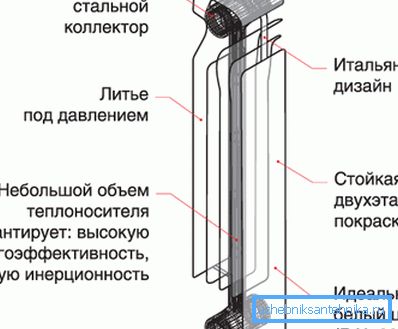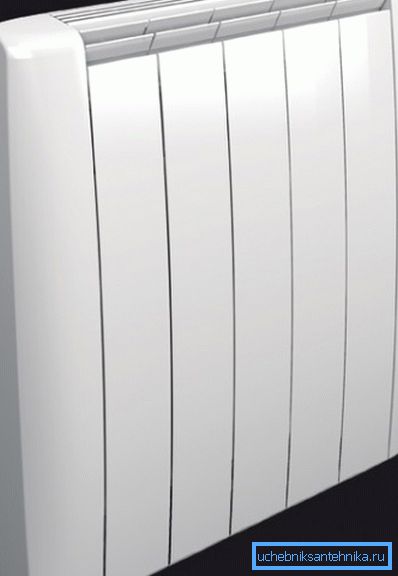Sira heating radiators: a fusion of quality and elegance
The efficiency of the home heating system depends not so much on the heating boiler, but on the radiators used, which transfer the heat energy of the coolant to the air in the room. This equipment should be not only powerful, but also beautiful to fit organically into the interior of the room. All these qualities have bimetallic radiators of heating of Syrah, which will be discussed further.

Bimetallic radiator device
Before proceeding to the consideration of specific technical characteristics and performance properties of batteries, let us examine in more detail what are the design features of the described climatic equipment.
Bimetallic radiators - Sira, Global, Rifar and others - are an aluminum heat exchanger, inside which steel pipes are laid. According to them, the circulation of the coolant.

They very successfully combine the advantages of durable metal panels and efficient aluminum radiators, but without their drawbacks.
Aluminum, due to its properties, has a very high heat transfer coefficient, but is highly susceptible to corrosion. From the latter, it is protected by steel, which, with the correct operation of the heating system, can last more than 20 years without destruction.
Note! The combination of these two metals allows you to give the battery increased strength. The destruction of the structure can only cause pressure in excess of 170 atmospheres, which is almost impossible in residential heating systems.
In addition, a bimetallic battery has the following advantages:
- improved corrosion resistance inside the battery;
- resistance to air and water impacts, which are typical for central heating networks of city apartments;
- excellent appearance - only designer radiators can be more beautiful than bimetallic radiators;
- resistance to aggressive chemical composition of water - steel, unlike aluminum, is well tolerated by acids;
- simplicity of installation - installation instructions for bimetallic radiator products for heating are available for understanding and implementation, because such batteries are an excellent choice for those who are building a house or changing heating in an apartment with their own hands.

However, it would be wrong to keep silent about some of the drawbacks that are inherent in the variety of equipment under consideration:
- price - bimetallic radiators are among the most expensive on the market;
- a small cross-sectional area of internal steel tubes — many do not consider this a disadvantage, since the small diameter allows the use of a smaller amount of coolant, which cannot but affect the efficiency of the heating system.
Sira - a model of efficiency and beauty
Features of Italian batteries
The Sira heating radiator, being one of the best representatives of bimetal radiators, organically combines the advantages of a steel core and an aluminum heat exchanger.

Thanks to the use of two materials, Sira batteries are distinguished by the following features:
- The presence of a metal frame completely eliminates the contact of the coolant with aluminum, so that the latter is protected from corrosion, which usually causes a bad coolant.
- The use of high-quality materials and continuous monitoring of the production process significantly increase the life of the radiator compared to similar products from other manufacturers.
- The special form of the heat exchanger increases the power of the panel. One section of the radiator allows you to heat a large area of the room, so you can use smaller batteries (or fewer sections).
But the main advantage of Sira radiators is an elegant and attractive appearance. Their characteristic curved body without sharp edges and protruding corners will not disappoint even the most fastidious buyer. In addition, they can be installed in children's and other similar institutions, where security is given increased attention.
Advantages of the Italian heating panels:
- innovative design and a smooth external surface - the batteries do not accumulate dust and are easily cleaned with ordinary household detergents;
- low inertia - after a minimum period of time after switching on, the air in the room will warm up to a comfortable temperature;
- strength - the radiator perfectly withstands high pressure inside the system (up to 170 atmospheres) and tolerates hydraulic and pneumatic shocks;
- a long period of operation - the absence of welds, which are often destroyed, allows the manufacturer to guarantee a 20-year period of operation of its products;
- the highest quality assembly technology of individual sections - using unique patented O-Ring gaskets;
- noiseless - during thermal expansion, the steel frame does not emit noises and crackles.

Note! Sira radiators are by far the best choice. Especially in the case when you want to design a heating system that works with several energy sources. So, some models of batteries can heat the room with the help of a heat transfer fluid or with electrical energy.
Species
Siri's widest range of radiators allows you to choose the model that perfectly matches your needs. The distance between adjacent sections can be from 300 to 800 mm. The power changes accordingly. Therefore, even in large premises, Italian bimetallic batteries will look organically.
The most common products are:
- Sira Bimetal. Steel-core aluminum batteries with no sharp corners or edges. Steel pipes with a diameter of 12 mm are used as a frame (the wall thickness is 1.25 mm). Thanks to such design features, maximum heat transfer is achieved. A bright representative of this type of battery is the bimetallic radiators Sira RS-500, RS-300 and RS-800.

- Sira Twin. These batteries can serve as part of the hydraulic heating system and operate on the mains. A special heat-radiating heating element makes their use as economical and safe as possible. Such radiators will be an excellent choice for homes where there are problems with the flow of coolant.

Conclusion
Whatever battery you choose, the quality of their work depends on the correct installation of the heating system. You can find out what rules to follow when designing climate networks from the video below.